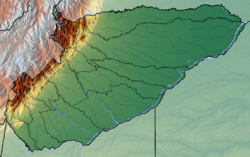Top Qs
Timeline
Chat
Perspective
Casanare Department
National subdivision in Colombia From Wikipedia, the free encyclopedia
Remove ads
Casanare (Spanish pronunciation: [kasaˈnaɾe], Spanish: Departamento de Casanare) is a department located in the central eastern of Colombia. It is famous for its oil and natural gas production as well as its livestock and extensive plains.[4] It is also the tenth largest department with an area of 44,490 km2, similar to that of Denmark, but also the seventh least densely populated.
Its capital is Yopal, which is also the episcopal seat of the Roman Catholic Diocese of Yopal.
It contains oil fields and an 800 km pipeline leading to the coastal port of Coveñas owned by BP.
Remove ads
Rivers and dams
The Upía River (Río Upía) is in Casanare.[5] Casanare, Ariporo, Guachiría, Guanapalo, Pauto, Tocaría, Cravo Sur, Cusiana, Túa y Upía.
History
A former subregion of Boyacá, Casanare became separate department in 1973.
Municipalities
Flag
The flag is divided diagonally from the upper-fly corner to the lower-hoist corner. The upper-hoist triangle is red and the lower-fly triangle, green. At the center of the flag is an eight pointed sun in yellow. The meanings attributed to the elements are that the color red symbolizes the blood spilled by its heroes, the color green its natural resources and its prairies, and the sun has eight corners that represent each letter of the word CASANARE.[7]
Remove ads
See also
References
Sources and external links
Wikiwand - on
Seamless Wikipedia browsing. On steroids.
Remove ads





